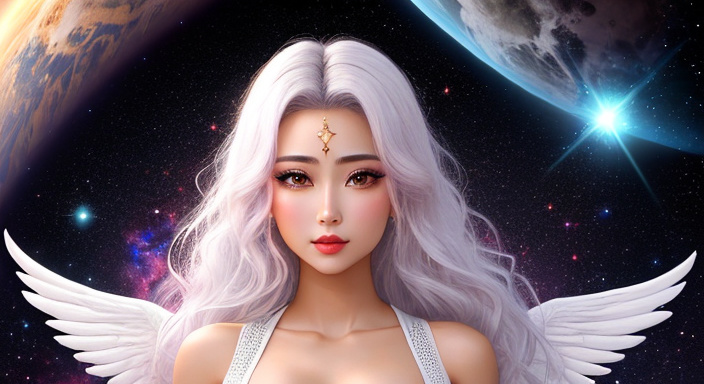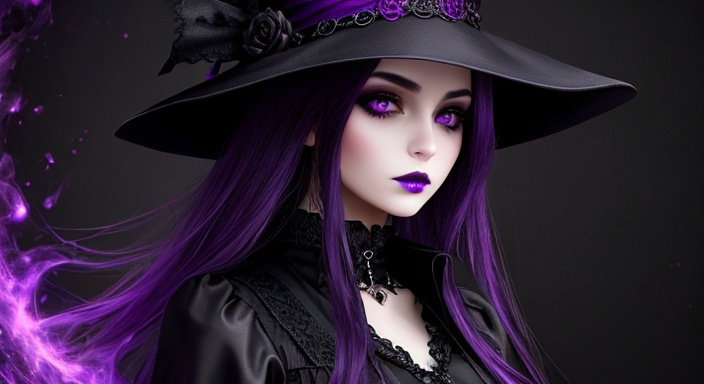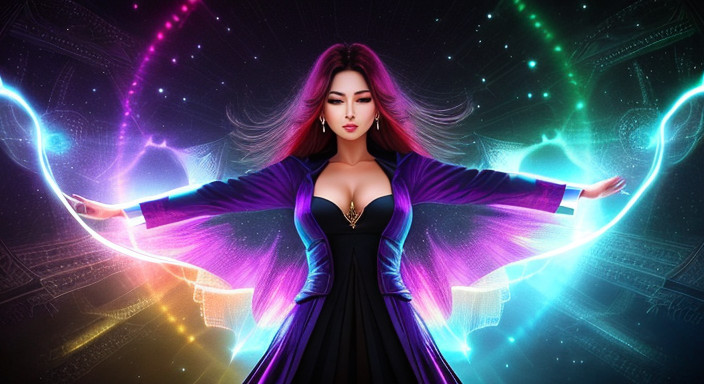
The human aura is a fascinating and intricate field of energy that surrounds every living being. While it is invisible to the naked eye, aura reading is an ancient practice that allows us to perceive and interpret these subtle energy fields. The study of auras provides valuable insights into a person’s emotional, mental, and spiritual well-being. It opens a doorway to understanding the interconnectedness of our energetic selves and the world around us.
An aura is often described as a luminous field of colors, vibrations, and patterns that extend beyond the physical body. It is believed to reflect an individual’s essence, thoughts, emotions, and overall energetic state. By reading auras, we can gain a deeper understanding of ourselves and others, unlocking hidden aspects of our being.
The colors within an aura are significant in aura reading. Each color carries its own meaning and can indicate different qualities or states of being. For example, vibrant and bright colors may signify vitality, joy, or spiritual awakening, while dull or murky colors may indicate emotional blockages or physical imbalances. By observing and interpreting these colors, we can gain valuable insights into an individual’s energetic landscape.
Aura reading is a skill that can be developed with practice and awareness. It requires the ability to attune oneself to subtle energies and to perceive beyond the physical realm. Enhancing our sensitivity to energy, practicing meditation, and engaging in other energy-based modalities can greatly support our journey in aura reading.
It is important to approach aura reading with an open mind and a sense of curiosity. While it is a metaphysical practice, aura reading has gained recognition and validation from various healing and spiritual traditions throughout history. It is a tool for self-discovery, healing, and gaining a deeper connection to the energetic tapestry of existence.
In this beginner’s guide to aura reading, we will explore various techniques, principles, and ethical considerations that will assist you in embarking on your own aura reading journey. Whether you are interested in understanding your own aura, reading the auras of others, or simply expanding your awareness of the subtle energies that permeate our reality, aura reading offers a profound and transformative path of exploration. So, let us delve into the realm of auras and discover the mysteries they hold.
Understanding Auras
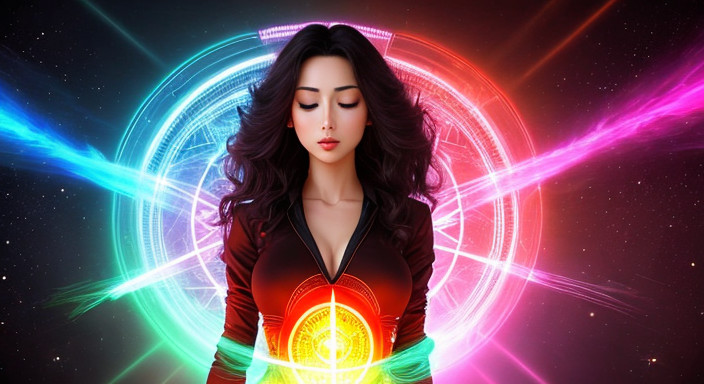
The human aura is a dynamic and ever-changing energy field. It is influenced by our thoughts, emotions, intentions, and overall state of being. Just as a pebble creates ripples in a pond, our thoughts and emotions create energetic waves that ripple through our aura, affecting its color, density, and vibrancy. By understanding and reading auras, we can gain deeper insights into the intricate interplay between our energetic, mental, and emotional states.
The colors within an aura hold significant meaning and provide clues about a person’s overall energetic state. Each color has its own unique vibration and symbolism. For example, a bright and vibrant yellow may indicate intellectual clarity, creativity, and optimism, while a murky or dark brown color may suggest feelings of stagnation, heaviness, or unresolved issues. By attuning ourselves to these colors and their meanings, we can decipher the energetic messages conveyed by the aura.
Furthermore, aura reading is not limited to colors alone. The aura may also exhibit various patterns, shapes, and movements. These visual cues can offer additional information about an individual’s energy, such as the presence of energetic blocks, imbalances, or even spiritual gifts. By honing our observation skills and developing a keen eye for detail, we can unravel the intricate tapestry of the aura and gain a deeper understanding of ourselves and others.
In summary, aura reading is a fascinating practice that allows us to tap into the subtle energies surrounding us. By understanding the unique qualities and meanings of colors, patterns, and shapes within the aura, we can embark on a journey of self-discovery, healing, and spiritual growth. Whether you are a beginner or have some experience in aura reading, this guide will provide you with the necessary tools and insights to explore and interpret the radiant world of auras.
What is an Aura Reading?
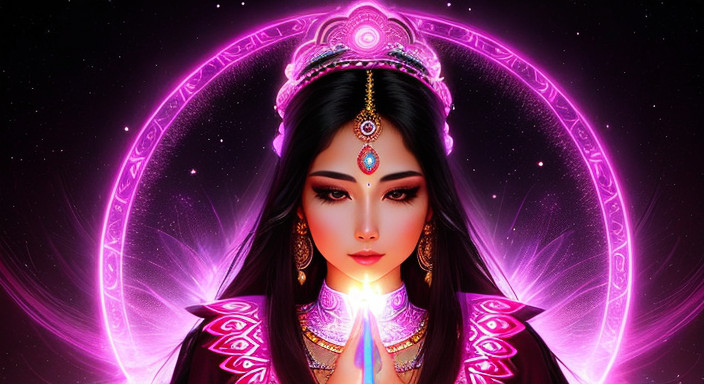
An aura reading is a practice that involves perceiving and interpreting the subtle energy field that surrounds a living being. The human aura is an electromagnetic field composed of energy vibrations that extend beyond the physical body. This energetic field is believed to contain information about a person’s physical, emotional, mental, and spiritual state.
During an aura reading, the practitioner uses their heightened sensory perception to observe and interpret the colors, shapes, patterns, and movements within the aura. By doing so, they gain insights into the individual’s energy dynamics, emotional well-being, and overall energetic balance. Aura readings can provide a deeper understanding of one’s strengths, challenges, and potentials, allowing for personal growth and self-awareness.
The process of an aura reading can vary depending on the practitioner’s preferred techniques and tools. Some practitioners may rely solely on their intuitive abilities, while others may incorporate additional tools such as crystals, pendulums, or specialized cameras to capture and analyze the aura’s visual representation. However, the core essence of an aura reading remains the same: to explore and interpret the energetic field surrounding a person.
Aura readings can be conducted for oneself or others. Self-aura readings offer a means of self-reflection, introspection, and personal growth. Reading the auras of others can be a valuable tool for healing, counseling, and gaining insights into their emotional, mental, and spiritual well-being.
It is important to approach aura readings with an open mind, respect, and ethical considerations. Aura readings should be conducted with the consent and permission of the individual involved, and practitioners should always maintain a non-judgmental and compassionate attitude. The goal of an aura reading is to provide support, guidance, and empowerment for personal growth and transformation.
An aura reading is the practice of perceiving and interpreting the energetic field that surrounds an individual. By observing the colors, shapes, and movements within the aura, practitioners gain insights into a person’s energy dynamics, emotional state, and spiritual well-being. Whether for self-exploration or offering assistance to others, aura readings can be a powerful tool for personal growth, healing, and gaining a deeper understanding of the intricate interconnectedness of our energetic selves.
Aura Photography
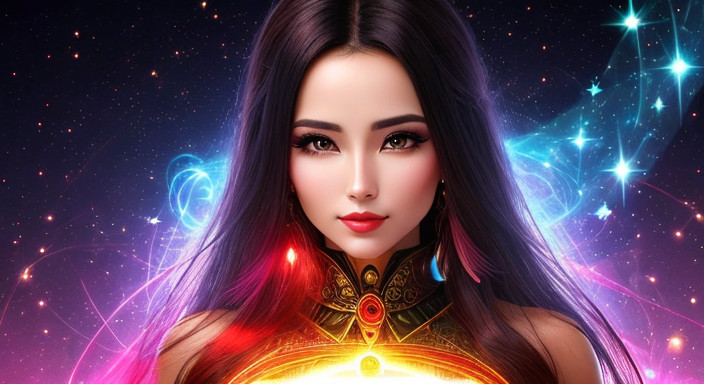
Aura photography is a specialized technique that captures and provides a visual representation of a person’s aura. It combines the principles of aura reading with modern technology to create a tangible image that reflects the energetic field surrounding an individual. Through the use of specialized cameras and sensors, aura photography aims to make the invisible visible, allowing individuals to see and explore their aura in a unique and tangible way.
The process of aura photography typically involves the individual placing their hands on specialized sensors or plates, which capture the energetic imprints and translate them into colors and patterns. These colors and patterns are then displayed in real-time on a computer screen or printed as a physical photograph. The resulting image shows the individual’s aura as a vibrant, multicolored field, providing a visual representation of their energetic state.
One of the benefits of aura photography is its accessibility and immediate feedback. Unlike traditional aura reading, which relies on the practitioner’s interpretation and description of the aura, aura photography offers a direct and visual representation that can be easily understood and interpreted by individuals. It provides a tangible validation of the energetic presence and can serve as a powerful tool for self-reflection, self-awareness, and personal growth.
Aura photography can also be a valuable tool for holistic practitioners, healers, and counselors. By capturing and analyzing a client’s aura photograph, practitioners can gain additional insights into the client’s energetic state, chakra imbalances, and potential areas of focus for healing and growth. It can enhance the effectiveness of energy healing sessions, as both the practitioner and the client can visually observe the energetic shifts and changes that occur during the healing process.
However, it is important to note that aura photography is not without its limitations. The interpretation of aura photographs still requires the understanding and expertise of a trained practitioner. The colors and patterns captured in the photograph may vary depending on factors such as lighting conditions, the individual’s state of mind at the time of the photograph, and the sensitivity and calibration of the equipment used. It is crucial to approach aura photography as a complementary tool rather than a definitive and absolute representation of the aura.
In conclusion, aura photography offers a unique and visually captivating way to explore and understand the energetic field surrounding individuals. It provides a tangible representation of the aura, allowing for immediate feedback and personal reflection. Whether for personal exploration or as a supportive tool for holistic practitioners, aura photography can enhance self-awareness, facilitate healing processes, and deepen our understanding of the intricate and dynamic nature of our energetic selves.
Observing Your Own Aura
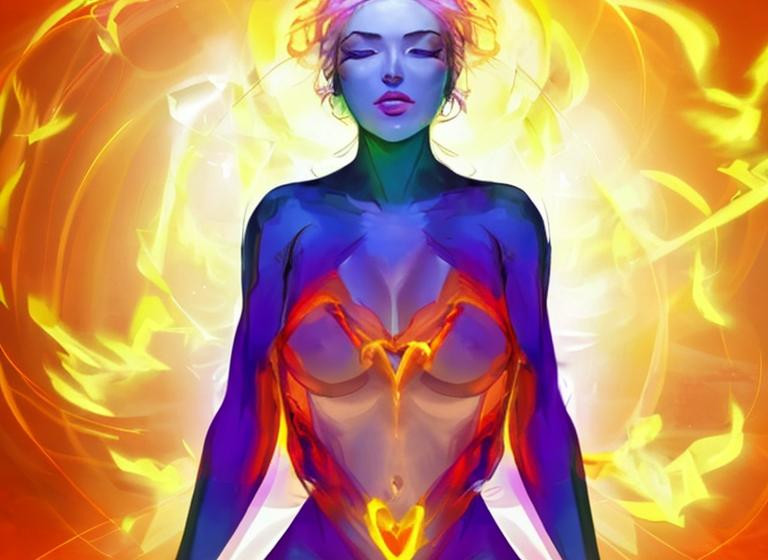
Embarking on your aura reading journey starts with the exploration of your own aura. By observing and becoming familiar with your own energetic field, you can develop a foundation for understanding and interpreting auras. Here are some steps to get you started:
- Create a Calm Environment: Find a quiet space where you can have some uninterrupted time for self-reflection. Ensure the room has a plain background, such as a white wall, to minimize distractions and allow for better visibility of your aura.
- Stand in Front of a Mirror: Position yourself in front of a full-length mirror, giving yourself enough space to see your entire body. Stand comfortably with good posture, feeling grounded and centered.
- Relax Your Gaze: Soften your focus and relax your gaze as you look at your reflection in the mirror. Instead of focusing on your physical features, direct your attention to the space around your body.
- Observe the Aura: As you relax and continue to gaze, you may begin to notice a subtle glow or a faint aura surrounding your body. It might appear as a color or a hazy, luminous field. Be patient and allow yourself to perceive any shifts or changes in the aura.
- Pay Attention to Changes: During your observation, be attentive to any variations in the aura’s color, brightness, or intensity. These fluctuations can indicate shifts in your energy, emotions, or overall well-being. Note any specific sensations or feelings that arise as you observe your aura.
- Practice Regularly: Like any skill, aura reading requires practice. Set aside dedicated time for regular aura observations to deepen your understanding and develop your sensitivity to the subtle energy field. With consistent practice, you will become more attuned to the nuances of your aura.
- Journal Your Observations: Keep a journal or notebook to record your observations and experiences. Document the colors, sensations, and any insights you receive during your aura reading sessions. Over time, you may notice patterns or connections between your energetic state and the observations you make.
Remember, aura reading is a personal and subjective experience. Trust your intuition and the information you receive during your observations. Each individual’s aura is unique, so your experience may differ from others’. Enjoy the process of exploring and understanding your own energetic field, allowing it to guide you on your journey of self-discovery and growth.
As you become more comfortable with observing your own aura, you can expand your practice to reading the auras of others, deepening your connection to the energetic world and the fascinating realm of aura reading.
Interpreting The Different Colors of Auras
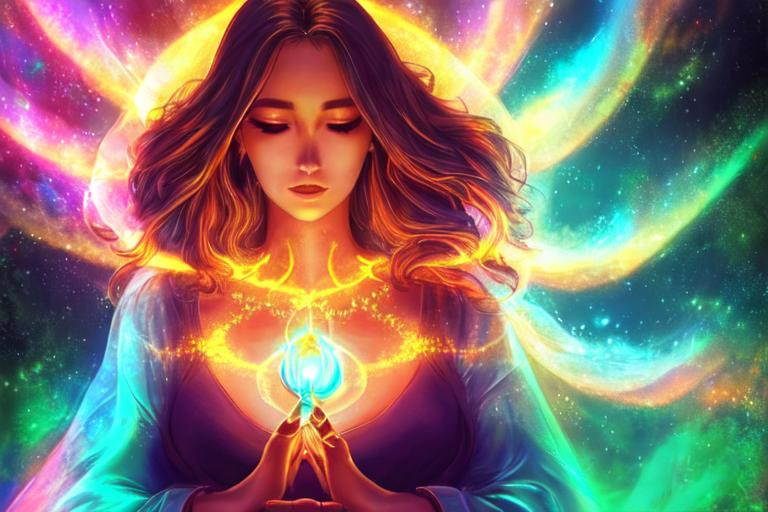
Auras are composed of a variety of colors, each carrying its own unique energetic qualities and symbolism. Understanding the different colors in an aura can provide valuable insights into an individual’s emotional, mental, and spiritual state. Here, we explore the meanings associated with various aura colors:
Red Aura:
A red aura typically signifies passion, vitality, and physical energy. It is often associated with individuals who are ambitious, courageous, and assertive. A strong red aura may indicate an individual who is passionate about their pursuits and driven to achieve their goals. However, it is essential to note that a predominantly red aura can also suggest anger, restlessness, or an excessive focus on material desires.
Yellow Aura:
A yellow aura represents intellect, clarity, and creativity. It is associated with individuals who possess a sharp mind, quick thinking, and a zest for learning. A bright yellow aura can indicate a person who is intellectually stimulated, confident, and optimistic. However, an imbalanced yellow aura may manifest as anxiety, overthinking, or a lack of focus.
Orange Aura:
An orange aura signifies enthusiasm, creativity, and emotional well-being. It is often observed in individuals who are passionate, sociable, and emotionally expressive. A vibrant orange aura can suggest a zest for life, joy, and an ability to connect deeply with others. However, an excessive orange aura may indicate emotional dependency or a tendency to seek validation from others.
Green Aura:
A green aura represents healing, balance, and growth. It is associated with individuals who possess a nurturing and compassionate nature. Those with a green aura often have a strong connection to nature, possess excellent healing abilities, and exhibit qualities of empathy and understanding. A vibrant green aura suggests a harmonious and balanced individual, while a muddy or dull green aura may indicate jealousy, resentment, or unresolved emotional issues.
Blue Aura:
A blue aura signifies calmness, communication, and spiritual awareness. It is often observed in individuals who are calm, intuitive, and possess strong communication skills. A bright blue aura suggests clarity of thought, inner peace, and the ability to express oneself effectively. However, a dark or murky blue aura may indicate emotional suppression, difficulty in expressing emotions, or a need for healing in the emotional realm.
Purple Aura:
A purple aura represents spiritual insight, intuition, and wisdom. It is associated with individuals who possess a deep connection to their spiritual selves and exhibit a strong sense of intuition. A bright purple aura suggests a person who is spiritually awakened, intuitive, and in touch with their higher consciousness. However, an imbalanced purple aura may indicate a tendency towards spiritual escapism or a detachment from the physical world.
Pink Aura:
A pink aura signifies love, compassion, and kindness. It is often observed in individuals who possess a nurturing and gentle nature. Those with a pink aura are often deeply empathetic, compassionate, and have a strong capacity for love. A vibrant pink aura suggests a person who radiates love and harmonious relationships. However, an imbalanced pink aura may indicate codependency or difficulties in setting healthy boundaries.
White Aura:
A white aura represents purity, spirituality, and divine connection. It is often observed in individuals who are spiritually evolved and possess a high level of consciousness. Those with a white aura are deeply connected to their higher selves and exhibit qualities of wisdom, clarity, and divine guidance. A radiant white aura suggests a person who is spiritually enlightened and connected to the higher realms.
Gold Aura:
A gold aura signifies divine wisdom, enlightenment, and spiritual mastery. It is associated with individuals who have reached a high level of spiritual development and possess profound spiritual insights. Those with a gold aura are often regarded as spiritual teachers, healers, or guides. A shimmering gold aura suggests a person who is aligned with their soul’s purpose and exhibits divine qualities.
Brown Aura:
A brown aura represents practicality, stability, and groundedness. It is often observed in individuals who are reliable, down-to-earth, and focused on the material aspects of life. A brown aura suggests a person who is practical, hardworking, and has a strong connection to the physical world. However, an imbalanced brown aura may indicate stubbornness, materialism, or a resistance to change.
Understanding the colors of auras can provide valuable insights into an individual’s energetic makeup. It is important to note that these interpretations serve as general guidelines, and individual variations and combinations of colors can influence the overall aura reading. Developing your intuition and observing the nuances of color within an aura will allow you to gain a deeper understanding of yourself and others as you embark on your journey of aura reading.
Can Your Aura’s Color Change?
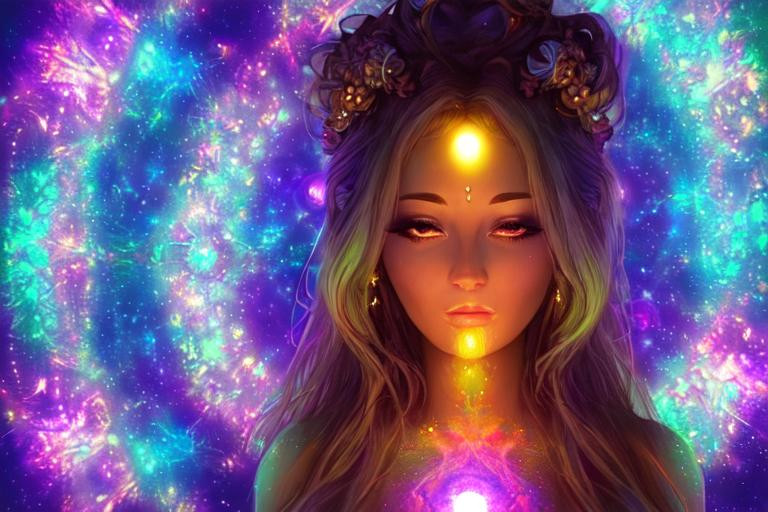
The colors of your aura can indeed change over time, reflecting the various shifts in your emotions, mindset, health, and spiritual development. Your aura is a dynamic representation of your current state of being, encompassing multiple layers of energy that are constantly in flux.
Significant life events, personal growth, shifts in mood, changes in health, and even alterations in your environment can influence the colors of your aura. For example, if you typically exhibit a calm and peaceful aura (typically associated with shades of blue or green), but find yourself going through a phase of intense creativity and passion, your aura may shift towards vibrant hues of orange or red to reflect your heightened energy and enthusiasm.
Similarly, when you experience stress, illness, or emotional turmoil, your aura may reflect these states by displaying colors that indicate imbalance or disharmony. It is important to note that these changes are often temporary and may return to their usual colors as your circumstances and well-being improve.
Engaging in regular practices such as meditation, energy work, aura cleansing, and maintaining a balanced lifestyle can contribute to a healthier, more vibrant aura. These practices help to restore and align your energy, supporting the return to your natural state of balance and harmony. By consciously working with your aura, you can facilitate positive changes in its colors and overall energetic composition.
Learning to read auras not only allows you to gain insight into your own energy but also empowers you to understand and connect with the energy of those around you. As you develop your aura reading skills, you can deepen your understanding of the energetic dynamics in your relationships and interactions, enhancing your ability to empathize, communicate, and navigate the world with greater awareness.
Remember that interpreting aura colors requires intuition and an understanding of the individual’s unique energetic makeup. Colors may vary in intensity, shade, and combinations, contributing to a more nuanced reading. Approach aura reading with an open mind and heart, trusting your instincts and the guidance provided by the colors that present themselves.
Embrace the journey of exploring and understanding your aura, knowing that it is a reflection of your ever-evolving self. Through this exploration, you can gain valuable insights, make positive changes, and cultivate a deeper connection with your own energy and the energies of the world around you.
The Different Types of Auras and Their Meanings
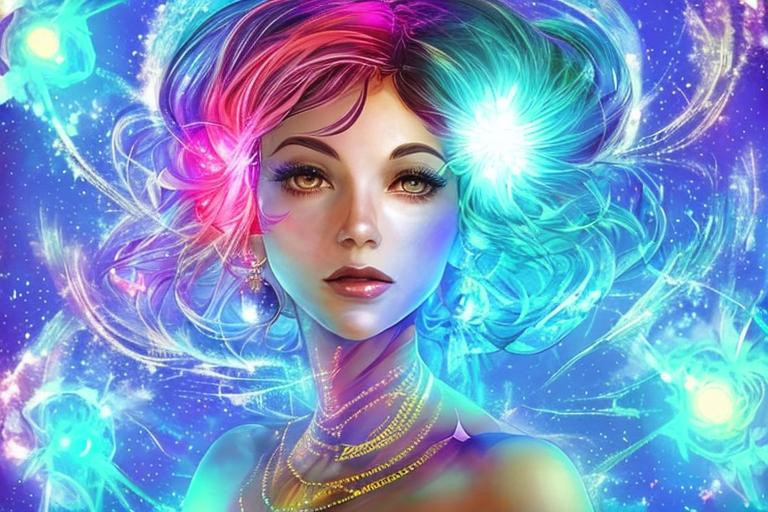
Auras come in various types, each carrying its own distinct characteristics and interpretations. Understanding the different types of auras can provide valuable insights into an individual’s personality, energy, and spiritual essence. Here are some common types of auras and their associated meanings:
Clear Aura:
A clear aura indicates a person who possesses clarity of thought, emotional balance, and a high level of self-awareness. Individuals with a clear aura often have a strong connection to their intuition and are adept at making conscious choices in alignment with their highest good.
Cloudy Aura:
A cloudy aura suggests confusion, emotional turmoil, or a lack of clarity. It may indicate that the person is going through a period of uncertainty or is experiencing inner conflict. Clearing and balancing the energy centers, practicing self-reflection, and seeking guidance can help restore clarity and bring about a more vibrant aura.
Prismatic Aura:
A prismatic aura is characterized by an array of shimmering colors, often reflecting a person’s multidimensional nature. It indicates a harmonious blending of various energetic qualities and can signify a person who is spiritually evolved, versatile, and adaptable.
Fluctuating Aura:
A fluctuating aura is characterized by changing colors or intensity. It may suggest emotional instability, mood swings, or a person who is highly responsive to their environment. Developing emotional resilience, grounding practices, and energy healing techniques can help stabilize and balance a fluctuating aura.
Expanded Aura:
An expanded aura is larger than the average aura and extends further from the body. It indicates a person with a strong presence, charismatic energy, and a broad perspective. Those with an expanded aura often have a magnetic influence on others and possess leadership qualities.
Contracted Aura:
A contracted aura appears closer to the body and may indicate a person who is introverted, reserved, or protective of their energy. It suggests a need for personal boundaries and self-care. Expanding the aura through energetic practices, self-expression, and engaging in activities that promote openness can support a more expansive energy field.
Incomplete Aura:
An incomplete aura may appear with gaps or areas of reduced energy. It can suggest emotional or energetic blockages, past traumas, or areas in need of healing. Working with energy healers, engaging in inner work, and practicing self-love can help restore the integrity of the aura and promote overall well-being.
Radiant Aura:
A radiant aura exudes a vibrant and luminous energy. It signifies a person who is aligned with their true essence, radiates joy, and has a positive impact on others. A radiant aura reflects inner harmony, self-acceptance, and a deep connection to one’s purpose and passion.
Protective Aura:
A protective aura is characterized by a strong and dense energy field that acts as a shield against negative influences. It indicates a person who is naturally resilient, able to set healthy boundaries, and is skilled at energy protection. Those with a protective aura often possess a strong sense of self and are less prone to absorbing external energies.
Mystic Aura:
A mystic aura is associated with individuals who have a deep spiritual connection, intuitive abilities, and a profound understanding of the mystical realms. It suggests a person who has awakened to higher truths, possesses wisdom beyond their years, and may serve as a spiritual guide or healer.
Thin or Weak Aura:
A thin or weak aura suggests a person who may feel depleted or lacking in energy. It can indicate a need for revitalization, self-care, and nourishment on physical, emotional, and spiritual levels. Engaging in practices that enhance energy flow, such as energy healing, self-care routines, and balancing activities, can help strengthen and restore the aura.
Dense Aura:
A dense aura appears heavy or solid, indicating a person who may be carrying emotional baggage, holding onto past experiences, or feeling weighed down by negative energies. Clearing techniques, emotional release work, and forgiveness practices can help release the density and promote a lighter, more vibrant aura.
Jagged or Spiky Aura:
A jagged or spiky aura is characterized by irregular, sharp edges or spikes extending from the aura field. It may suggest emotional volatility, tension, or unresolved conflicts. Engaging in stress-reducing practices, cultivating emotional balance, and practicing self-soothing techniques can help smooth and harmonize the aura.
Holes or Gaps in the Aura:
The presence of holes or gaps in the aura can indicate energy leakage, vulnerability, or areas of energetic imbalance. It may suggest a need for energetic protection, boundary setting, and inner healing. Strengthening the aura through visualization exercises, energy healing modalities, and self-empowerment practices can support the repair and wholeness of the aura.
Elongated or Extended Aura:
An elongated or extended aura surpasses the average aura size, reaching greater distances from the body. It signifies a person with expansive energy, heightened spiritual awareness, and a strong connection to higher realms. Those with an elongated aura often have visionary abilities, access to higher guidance, and may serve as channels for divine inspiration.
Uniform Aura:
A uniform aura exhibits a consistent color or energy throughout the entire aura field. It suggests a person who is balanced, integrated, and aligned on all levels of their being. Individuals with a uniform aura often radiate a sense of inner harmony, clarity, and purpose.
Fiery Aura:
A fiery aura is characterized by vibrant, intense colors reminiscent of flames. It signifies a person with a passionate, dynamic nature and a strong life force energy. Those with a fiery aura often possess determination, enthusiasm, and a zest for life. Balancing practices, such as meditation and grounding techniques, can help channel and direct this fiery energy constructively.
Elemental Aura:
An elemental aura appears as a subtle blend of colors and patterns, representing the four natural elements—earth, air, fire, and water. Individuals with an elemental aura often exhibit colors that correspond to their dominant elemental influence. For example, earth elementals may have hues of brown and green, air elementals may display shades of light blue or yellow, fire elementals may radiate vibrant reds and oranges, and water elementals may emanate calming blues and shades of aqua. The appearance of these elemental colors in the aura signifies a strong affinity and attunement to the elemental forces, as well as possessing elemental qualities within their personality.
Astral Aura:
The astral aura appears as a luminous and ethereal field surrounding the physical body. It can have a dreamlike quality, with soft, pastel hues and a subtle shimmering effect. Those with an astral aura often display colors associated with the realm of emotions, such as pale blues, purples, pinks, and silver. The astral aura signifies a person who is highly attuned to astral realms, dreams, and the realm of emotions and desires. Individuals with an astral aura may experience vivid dreams, possess strong intuitive abilities, and have a natural inclination towards exploring and understanding the depths of their emotions. Their aura may also fluctuate or shift in response to their emotional state, reflecting the ebb and flow of their inner world.
Remember that the appearance of auras may vary from person to person, and it’s essential to rely on your intuition and personal experiences when interpreting aura colors and patterns.
The 7 Layers of Your Aura

The aura is intricately connected to the seven energy centers of the body, known as chakras, and consists of seven distinct layers, each with its own characteristics and significance.
The depth and size of these aura layers vary from person to person and can also fluctuate depending on their current life circumstances and energetic state.
In a healthy state, the aura expands several feet around the body and radiates vibrant colors. Conversely, when the aura is unhealthy or weakened, it may appear smaller and lackluster.
The layers of the aura emanate outward from the body, with the first layer being the closest and the seventh layer being the furthest.
As the layers progress outward, their vibrations increase, with the seventh layer carrying the highest frequency.
Furthermore, the odd-numbered layers possess a more structured nature and embody yang energy, while the even-numbered layers exhibit a fluid quality and embody yin energy. This harmonious interplay of energies within the aura promotes balance and equilibrium in our overall energetic system.
1st Layer: Etheric
The Etheric layer is the closest to the physical body, representing the physical aspects such as muscles, tissues, and bones. It manifests as a bluish grey color and is easily perceptible to the naked eye. This layer pulsates at a rate of 20 cycles per minute and is most pronounced in individuals who lead active lifestyles and athletes. However, it tends to weaken in those with sedentary habits or compromised immunity. Connected to the root chakra, the Etheric layer forms the foundation of our energetic system.
2nd Layer: Emotional
The Emotional layer resides just above the Etheric layer and serves as a repository of our emotions and feelings. It encompasses a wide range of colors, mirroring the kaleidoscope of our emotional experiences. During times of emotional stress, this layer can become muddied in appearance. It is closely linked to the sacral chakra and provides valuable insights into the state of our chakras and emotional well-being.
3rd Layer: Mental
The Mental layer, positioned third from the physical body, governs our thoughts, cognitive processes, and state of mind. Radiating a vibrant yellow hue, it is connected to the Solar Plexus Chakra. The Mental layer often appears strongest around the head, neck, and shoulders. Individuals who engage in mental tasks or possess an active mind may exhibit a more prominent Mental layer. Engaging in creative activities can also cause colored sparks to flow from this layer.
4th Layer: Astral
The Astral layer, located fourth from the physical body, is associated with the formation of astral cords, which signify our relationships and connections with others. It exudes a delicate pink or rosy color and is linked to the heart chakra. The strength of the Astral layer is heightened through loving and intimate relationships, while it may weaken during conflicts or breakups with loved ones. Additionally, the state of the chakras can be easily discerned from this layer.
5th Layer: Etheric Template
Positioned fifth from the physical body, the Etheric Template layer encompasses the blueprint of our entire physical existence on this plane. It encompasses everything we create at the physical level, including our identity, personality, and overall energy. Connected to the throat chakra, this layer can vary in color. Expressing our authentic truth and embracing self-awareness strengthens and heals the Etheric Template.
6th Layer: Celestial
The Celestial layer, situated sixth from the physical body, emanates a powerful and heightened vibration. Connected to the third eye chakra, it signifies our connection to the Divine and all other beings. Within this layer, unconditional love and feelings of oneness flow effortlessly. Exhibiting a pearly white color, the Celestial layer holds immense spiritual significance. When the Celestial layer is strong, individuals may possess the ability to communicate with the spirit world and receive angelic messages. Unconditional love serves as a healing force for this layer.
7th Layer: Ketheric Template
The outermost layer, known as the Ketheric Template, resides approximately 2 to 3 feet away from the physical body. Vibrating at the highest frequency, it engenders the profound sensation of being one with the Universe. This golden-hued layer contains comprehensive information about our soul’s journey and past lifetimes. Connected to the crown chakra, the Ketheric Template pulsates rapidly. When this layer is robust, it enables individuals to surrender to the path of the Divine and may amplify psychic abilities, facilitating a deeper connection with spiritual realms.
The Relationship Between Auras and Chakras
The relationship between auras and chakras is a profound and interconnected one, as these two aspects of our energetic anatomy greatly influence and complement each other. Understanding this relationship can provide valuable insights into our holistic well-being and spiritual growth.
Auras, the radiant energy fields that surround our bodies, are intricately linked to the seven chakras, which are the main energy centers within us. The chakras act as gateways that receive, assimilate, and distribute vital life force energy throughout our entire being. They are responsible for maintaining the balance and flow of energy in our physical, emotional, and spiritual bodies.
Each layer of the aura corresponds to a specific chakra, creating a harmonious interplay between the two. The condition and activity of the chakras directly affect the health and quality of the corresponding aura layer, and vice versa. When the chakras are balanced and vibrant, the aura radiates with brightness and vitality. Conversely, imbalances or blockages in the chakras can lead to disturbances in the aura’s energy field.
By working on our chakras, we can influence the state of our aura and vice versa. Balancing and activating the chakras through various techniques such as meditation, energy healing, and sound therapy can help cleanse and strengthen the aura, allowing for a greater flow of energy and a heightened sense of well-being. Similarly, nurturing and maintaining a healthy aura through practices like aura cleansing, energy work, and self-care can contribute to the harmonious functioning of the chakras.
Understanding the relationship between auras and chakras empowers us to take an active role in our energetic health and spiritual development. By nurturing and balancing both our aura and chakras, we create a strong foundation for overall well-being, personal growth, and a deeper connection with our higher self and the divine energy that surrounds us.
The Seven Chakras
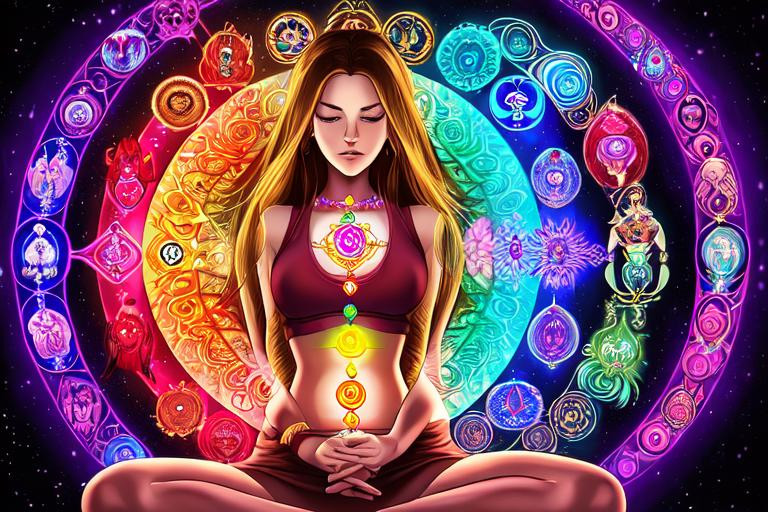
The seven chakras, each associated with a specific color, are believed to be reflected in the colors present within our auras.
Red:
The Root Chakra, represented by the color red, is located at the base of the spine and is associated with grounding, stability, and a sense of security.
Orange:
Located in the lower abdomen, the Sacral Chakra is symbolized by the color orange and is connected to creativity, sexuality, and the experience of pleasure.
Yellow:
The Solar Plexus Chakra, represented by the color yellow, resides in the upper abdomen and is associated with personal power, confidence, and a healthy sense of self-esteem.
Green:
Located in the center of the chest, the Heart Chakra is depicted by the color green and is linked to love, compassion, and emotional balance.
Blue:
The Throat Chakra, represented by the color blue, is situated in the throat area and is connected to communication, self-expression, and the pursuit of truth.
Indigo:
The Third Eye Chakra, depicted by the color indigo, is located in the center of the forehead and is associated with intuition, wisdom, and deep spiritual insight.
White:
The Crown Chakra, represented by the color violet or white, resides at the top of the head and is linked to our connection with the divine, spiritual enlightenment, and the transcendent realm.
How to Read Auras
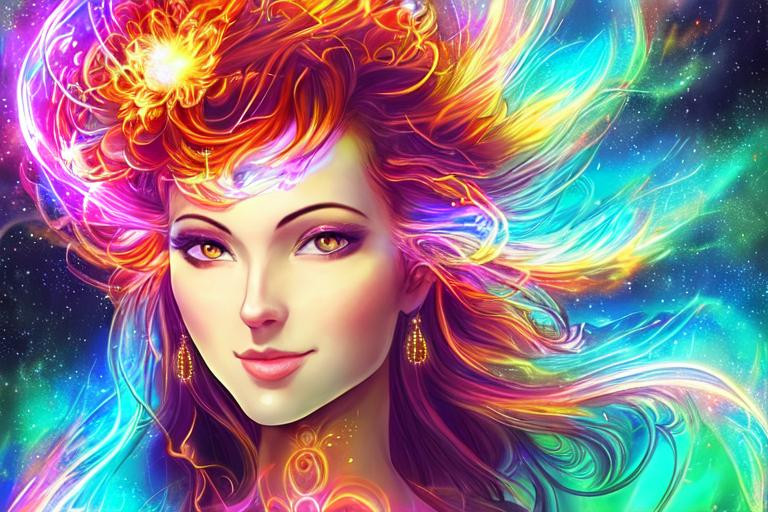
If you have a curiosity about delving into the realm of aura reading and want to learn how to read auras for yourself, there are numerous techniques at your disposal to begin exploring this captivating facet of energy work.
Aura Reading Techniques
Enhance Your Sensitivity to Energy:
Begin your journey of aura reading by cultivating your sensitivity to energy. You can do this by placing your hands a few inches apart and gradually moving them closer together and further apart, attuning yourself to any subtle sensations you may feel. Additionally, spending time in nature and connecting with the energy of plants, trees, rocks, and other natural elements can help you develop your awareness of subtle energy beyond your physical senses. Pay close attention to how you perceive and receive these subtle energies.
Engage Your Peripheral Vision:
One of the widely practiced methods for seeing auras involves utilizing your peripheral vision. To do this, focus your gaze on an object directly in front of you. Without shifting your eyes, try to expand your awareness to the area surrounding the object. You may notice the presence of a hazy or colored aura encircling it.
Harness the Power of Meditation:
Meditation serves as a potent tool for honing your aura reading abilities. By quieting your mind and learning to concentrate your attention, you can heighten your sensitivity to the subtle energies that surround you. Set aside dedicated time each day, even if it’s just a few minutes, to engage in meditation. As you become more comfortable with the practice, you may find that you develop a greater capacity for sensing the energy fields of people and objects.
Adopt a Soft Gaze:
When aiming to visually perceive auras, adopt a soft gaze by looking slightly to the side of the person or object, rather than fixing your eyes directly on them. This technique resembles utilizing peripheral vision and can facilitate the visualization of auras.
Choose a Neutral Background:
For beginners, it is easier to observe auras against a white or neutral background. Request the person you are practicing on to stand against a white wall while you gently focus your gaze above their right shoulder. Initially, concentrate on a specific spot, and then gradually shift your gaze to the space surrounding or just above their head. Look for a kind of haze or white light enveloping them.
Take Note of the Colors:
Once you are able to perceive the presence of a white light or haze around a person, you may begin to notice a subtle sense of color within that energy field. These colors can range from faint to vibrant, and from clear to cloudy. Take note of the colors you observe and their characteristics. What do the colors reveal about the aura?
Interpret the Colors:
Each aura color holds a general meaning. For example, red often symbolizes passion or energy, blue signifies calmness and communication, and green represents healing or growth. While you can refer to resources that outline the meanings of aura colors, allow yourself the space to intuitively interpret what these colors may signify. Tap into your own senses and insights to decipher the messages conveyed by the aura colors—whether it pertains to others or your own aura.
Engage in Regular Practice:
Like any skill, aura reading improves with practice. Begin by practicing on friends, family members, or even yourself in front of a mirror. Remember to be patient with yourself throughout the process. It’s absolutely fine if you don’t immediately perceive colors. With consistent practice, your ability to see and read auras will sharpen and become more refined.
By employing these techniques, you can embark on the journey of developing your aura reading abilities and gain deeper insights into your own energy field. Approach aura reading with an open mind, maintaining a sense of curiosity, and feel free to experiment with different methods until you discover the ones that resonate best with you.
Aura Cleansing: Purifying Your Energy Field
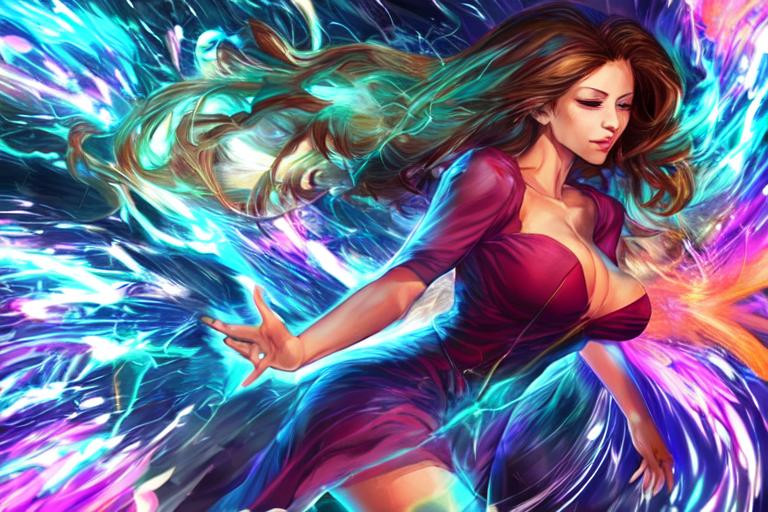
In the journey of exploring auras, it is essential to acknowledge that sometimes auras can become clouded or congested, which in turn can manifest as physical or emotional imbalances. To restore harmony and vitality, aura cleansing techniques come into play, allowing for the removal of negative energy and the revitalization of your energetic being.
Numerous approaches exist to cleanse your aura, ranging from meditation and visualization to energy healing modalities. One effective technique involves envisioning yourself enveloped in a luminous, radiant white light. This powerful visualization helps to disperse any stagnant or harmful energy that may have accumulated within your aura. As you visualize the white light surrounding you, imagine it effortlessly dissolving and transmuting any negative influences, leaving you feeling refreshed, renewed, and rejuvenated.
Furthermore, various tools and aids can complement your aura cleansing practice. Crystals, for instance, possess unique energetic properties that can assist in purifying your aura. Select crystals such as clear quartz, selenite, or amethyst, and hold them in your hands or place them on your body during your aura cleansing session. Their inherent vibrations and cleansing qualities help to amplify the energy clearing process, promoting a harmonious energetic state.
Essential oils can also be utilized to enhance the cleansing of your aura. Incorporate essential oils with purifying properties, such as lavender, frankincense, sage, or rosemary, into your practice. Apply them topically to pulse points, diffuse them in your surroundings, or add them to a bath or massage oil. These aromatic allies work synergistically with your intention and support the purification and restoration of your energetic field.
By developing a mindful awareness of your aura and prioritizing its well-being, you can significantly enhance your overall state of being. A cleansed and balanced aura acts as a magnet, attracting positive energy and experiences into your life. Incorporating regular aura cleansing practices into your self-care routine can foster a sense of clarity, vitality, and alignment, allowing you to navigate life from a space of energetic integrity.
Remember, each person’s aura is unique, and the approach to aura cleansing may vary. Experiment with different techniques, follow your intuition, and trust your inner guidance as you embark on the journey of purifying your energy field. Embrace the transformative power of aura cleansing as you embark on a path of self-discovery and energetic wellness.
Final Musings:
As we conclude our exploration into the captivating realm of aura reading, we invite you to embark on your own personal journey of discovery. Remember that reading auras is not just a skill, but a profound opportunity for self-reflection, understanding, and connection. Embrace the beauty of your intuitive senses and the limitless potential they hold in unraveling the mysteries of energy and consciousness.
May your aura reading endeavors be filled with curiosity, wonder, and compassion. As you learn to discern the vibrant colors, subtle nuances, and energetic signatures that compose the human aura, may you develop a deeper appreciation for the interconnectedness of all beings and the intricate dance of energies that shape our experiences. Let your intuition guide you, trust in your inner wisdom, and remain open to the revelations that unfold before you.
In the radiant tapestry of life, may your aura reading abilities become a beacon of light, illuminating the path towards self-discovery, healing, and spiritual growth. Embrace the profound insights that the aura offers and allow it to serve as a constant reminder of the expansive and interconnected nature of our existence. May you radiate love, harmony, and compassion, both within and around you, as you navigate the vibrant landscapes of energy that surround us all.

